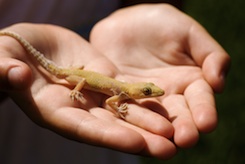Read more!
For apartment-dwelling kids or families who have limited space,
traditional pets might not be a great fit. Reptiles, however, typically
live in self-contained environments that require a relatively small
space commitment. While not all reptiles are ideal choices for kids,
there are many that could prove to be perfect for your family. Here are
10 of the most kid-friendly pet reptiles.
- Corn Snakes – As a general rule, snakes require
significantly less space and attention than many other types of
reptiles, making them ideally suited to live in a tank inside an
easily-distracted child’s room. The slender bodies of corn snakes are
easy for children to handle, but be warned: they can also be masters of
escape if housed improperly or if the lid to their habitat is left
unlatched.
- Ball Pythons – For kids that want a snake with a
heftier body, the Ball Python might be a good choice. The humidity and
temperature of their habitats do need to be carefully monitored, but
they’re relatively low-maintenance pets that are typically very tolerant
of excessive handling.
- Leopard Geckos – Hardy and tolerant to handling,
the leopard gecko’s diet of insects, vegetables and greens is easily
acquired and can be handled by an older child without much assistance.
The biggest drawback to the leopard gecko is its nocturnal nature, which
can cause kids to become less interested when they discover that it
sleeps for most of the day and is active at night.
- Bearded Dragons – One of the most popular lizards
for children’s pets is the bearded dragon, which can grow up to two feet
long in adulthood and subsists on a mixed diet of insects and
vegetables. Bearded dragons typically have good personalities and are
well-suited to children.
- Fat-Tailed Geckos – Generally quite docile and easy
to tame, the fat-tailed gecko is another suitable reptile for children,
and their 10 inch average size is easy for smaller hands to
accommodate. They are also very tolerant to regular handling. They
typically live for 15 to 20 years, so you’re not likely to have to
handle the delicate subject of death when your child is still too young
to process the concept properly.
- Fire-Bellied Toads – Despite their ominous-sounding
name, the fire-bellied toad can be the perfect pet for a frog-loving
child. They also can survive comfortably in a smaller environment and
are generally less expensive and less difficult to keep up than other
types of reptiles.
- King Snakes – Slower-moving than many of their
snake relatives, the king snake is small and quite friendly. With proper
handling, the king snake is far less likely to bite than other species,
and is also much easier for children to hold securely.
- Box Turtles – These turtles have acquired the
reputation of being quite easy to care for, which is sometimes true and
sometimes not. Their disposition typically depends on the area in which
you live and whether or not the box turtle is a naturally-occurring
species and if you plan to house it outdoors. If your accommodations are
adequate and you provide proper care for your new box turtle, it can
live for a very long time. It is very important, however, that you make
sure that the turtle you’re purchasing was captive bred; laws governing
the sale of these reptiles have caused a huge spike in the capture of
wild adults, which is rapidly diminishing the number of these creatures
in their natural habitats.
- Crested Geckos – Less finicky about heat than some
of their lizard brethren, the crested gecko does require a vertical cage
to accommodate his ability to walk vertically across a surface. Though
the crested gecko is another nocturnal lizard, their relative
ease-of-care makes them one of the better choices for kids.
- Anoles – Though their five to seven year lifespan
is significantly shorter than those of many other lizards, the anole is
quite small and can change colors from green to brown. Docile after
taming, they can tolerate capable handling once they’ve become
accustomed to it, though they are easily frightened in some cases.
It’s important to carefully research the habits and needs of a
particular reptile before bringing it home, as there are many factors
that make specific creatures less than ideal for kids. Some, for
instance, can become so stressed from frequent handling that their
health is affected. Also, children that are too young to understand
proper hygiene should never handle a reptile without adult supervision,
as some varieties can carry the salmonella virus, which can be easily
spread if kids don’t wash their hands thoroughly. Be sure to take your
time before making your decision to ensure that both your child and
their new pet are happy and healthy.
Posted on December 5, 2012 by admin | in Nannies
Read More......

![]()


